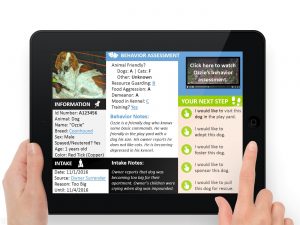A few years ago, in the height of my workaholism, I took up a hobby. I go to sketchy neighborhoods around L.A. and hang out with dogs I don’t know.

I have a long history of adopting and fostering shelter dogs, often getting them out on their “euth dates.” With almost 4 million homeless animals losing their lives every year in the United States, I wanted to do something more than robotically write donation checks. So I go to the shelter, choose the most hard-to-place dogs, videotape them, and post the videos on social media. It turns out that 93 percent of the dogs I video find homes.
How do I know this? From my data! I keep a running log of the dogs I video, their breeds, their ages, and the reason they enter the shelter in the first place. Though it might not be hugely voluminous—I’ve videotaped hundreds of dogs, not tens of millions—if you’re a dog hours away from being put to sleep it’s “big data” to you.
Some of my findings are no surprise. Anyone who’s been in an animal shelter knows that the vast majority of dogs who need homes are pit bulls (according to my data it’s 46 percent), followed by Chihuahuas (23 percent). Then come German Shepherds, Chows, Rottweilers, and variations of all of the above. While mixed breed dogs figure prominently, 38 percent of the dogs I meet in the shelter are purebreds.
But the potential for this data transcends my Facebook videos. What if the politicians who govern public shelters were data-driven?
We could enrich data about dogs and adoption rates, discovering demographic clusters of owners who surrender their dogs, and where they live. This could justify funding for mobile spay and neuter clinics in those neighborhoods. We could pinpoint patterns of abuse, and use that to focus law enforcement efforts, or reward informants for exposing dog-fighting rings. We could fund intervention programs to help low-income families find housing and low-cost veterinary services, allowing them to keep their pets. We could modernize microchips to stream location data so that people who lose their pets find them quickly!
We could also use this data to deploy modern technology in shelters, bringing them into the digital age. Picture tablets in kennels that display profiles of every animal. Having information where the animals are could prevent long lines of potential adopters seeking information, pulling shelter employees away from their desk jobs and into the kennels to expedite adoptions.
Here’s a rendering of what I call a Doggie Dashboard, complete with a detailed description of the dog’s attributes and behaviors, and encouraging action:
You can see where I’m going with this. We’re profiling shelter animals and potential adopters in order to move them through the system, in the process optimizing the experience for both!
It’s not just about animals. The parallels between monitoring adoptions and monitoring the customer journey are striking. After all our companies have been tracking customer behaviors and preferences for decades. My second book, The CRM Handbook was published by Addison-Wesley back in 2002. Since then the tenets of customer experience management have become a strategic imperative.
Imagine applying these same principles to state-funded programs like child services, public health programs, family assistance, and welfare-to-work initiatives. In all of these cases data drives improvements, efficiencies, and economies of scale. If data can be used for a good cause, then big data can be used to start a revolution!
Are my shelter statistics “big data?” They are to Ozzie. Ozzie — pictured in the dashboard above—was adopted from Baldwin Park shelter an hour before being led into the back room to be put to sleep. That was back in 2011. Nowadays, he hangs out on my living room sofa.
I’ll be talking about applying big data and digital technology at the Women in Big Data Forum at Strata San Jose on March 30. You can also stop by the SAS booth 1022 at 3:30 and get a copy of my latest book, The New IT: How Technology Leaders are Enabling Change in the Digital Age. Come see me, and share photos of your rescue pets! Here’s to big data one customer, citizen, patient, taxpayer, and yes, one dog at a time.

7 Comments
Big Data saving Best Friends. Beautiful. And woof! All possibilities you touch on are thrilling. Looking forward to tuning in to your next presentation. Judges give this 4 our of 4 galloping free paws up!
Thanks, Patricia! We need to take this global!!! #onedogatatime
Matching products to customers, matchings dogs to homes. The analytics are essentially the same, but one of them will sleep on your lap when it's cold outside. Great post, Jill!
I'm so glad you posted this, Cat, since that was the point--there are so many parallels between optimizing our businesses with digital and analytics solutions and optimizing animal shelters. So happy you saw the relationship! Thanks for the comment.
Great article. Thank you Jill for helping these dogs find a forever home and using data to do this is just awesome.
Hi, Diana! Who knew we could apply digital technologies and visualizations to saving shelter animals? (SAS did.) Thanks for commenting on this!
Pingback: Big data, one dog at a time | 7wData